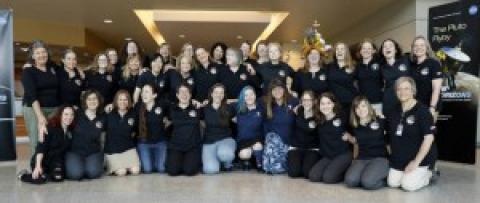Even with Iran nukes, and Greece surrender, and Donald Trump to absorb you this week, you can hardly have escaped immersion in NASA’s New Horizons mission and the triumphant Pluto flyby. Still, here are some bloggeries about this extraordinary space adventure that you may not have encountered yet.
Dan Satterfield, of Dan’s Wild Wild Science Journal (an American Geophysical Union blog), posted a 14-minute video of scientifically accurate Pluto chaff between Stephen Colbert and Neil deGrasse Tyson. From which I learned that, comparatively speaking, if Neptune was the size of a Chevvy Impala, Pluto would be the size of a Matchbox car.
Mike Summers, one of the New Horizons team members, blogs about the history of the New Horizons project, and the jubilation over its success, at The Conversation.
I was bowled over by the news that New Horizons is carrying the ashes of Clyde Tombaugh, who discovered Pluto in 1930. But so says Chris Arridge, who also explains at The Conversation how New Horizons scientists are coping with its ancient technology–more than ten years old, and in some cases closer to 20.
It had never occurred to me that there would be confusion over how to pronounce the name of Pluto’s largest moon, which is surely SHARE-on. But apparently there is confusion, even among the New Horizons scientists, as Nick Stockton complains at Wired. Also, I learn there, the moon was not, after all, originally named Charon after the mythological ferryman from Hell who carried souls across the river Styx. No, the name was based on the name of Charon’s discoverer’s wife.
SciGuy Eric Berger ponders what has just been learned about the science of Pluto and its moon Charon. Both have features–11,000-foot ice mountains, for example, and a remarkable lack of cratering–that suggest recent geological activity and a very young surface.
But that implies these deepest of deep-freeze objects, which have orbited 3 billion miles from the sun for billions of years, might retain enough core heat for . . . volcanos? Or are there tectonic plates? Is Charon big enough to cause tidal heating on Pluto? Is Pluto radioactive? George Dvorsky speculates and speculates at io9, but in the end throws up his hands and declares, “This really is completely crazy.”
If you want to consult one source only, see what Joseph Stromberg has done at Vox. You’ll be there a while, because it’s lots, including photos. He also contributes 6 amazing things the mission has taught us so far. And a thorough explanation, with diagrams, about Pluto’s demotion to dwarf planet status and whether it and a few other similarly sized round Kuiper Belt objects should be declared (or in Pluto’s case re-declared) to be planets.
AND FINALLY
New Horizons apparently has the technical capacity to study another Kuiper Belt object while it’s there; all it needs is money. Mika McKinnon, at Gizmodo, wants you to plead with your Congressperson for more cash to carry out this additional mission.
At NASA Watch, Keith Cowing is grumpy. Again. “To be certain, this mission is nerd cool and exciting – and inspirational – even if you do not know all (or any) of the science behind it. But at the end of the day, how many of the 300,000,000 people who paid for this truly understand what was done, why it was done, and why it was more important to spend ~$700,000,000 on this as opposed to [fill in the blank].”
Cowing is particularly miffed at NASA’s claim that the mission to Pluto was a necessary step to the mission to Mars, which he declares to be nonsense. “You do not need to go 3 billion miles to Pluto so that you can go 100 million or so miles to Mars and back.” That’s because NASA can muster enough funds to occasionally do impressive missions like a journey to Pluto and beyond, “but nowhere near enough to do the big things that its Public Affairs office would have you think are a done deal.”
For an entirely different view of NASA’s PR operation, see Adam Epstein’s longish and admiring piece at Quartz detailing how NASA mastered viral tweets and took over the Internet this week.
The New Horizons mission is noteworthy for another reason: the number of women working on it. “This may be the mission with the most women in NASA history,” says Adrienne LaFrance at The Atlantic. Or it may not be. The assertion is equivocal because she presents no numbers. Alice Bowman is the mission operations manager, acronymed MOM. I am hoping that “mission operations manager” is the usual title for the US taxpayers’ space projects, and that other such are known as MOM too. Even when they possess Y chromosomes.
But let’s conclude on a nonquarrelsome upnote from Steven Novella at Neurologica: “[The New Horizons mission] is a stunning validation of not only astronomy and physics, but of science itself. No other intellectual tool developed by humans has achieved such a success. No dowser, psychic, or spiritualist could have divined the information necessary to target the probe. No astrologer could have given us this information. Alchemy could not have powered the rockets so powerfully and precisely. . . This will be remembered as an achievement of our species, of our civilization, and of the power of science.”
Tabitha Powledge is an award-winning long-time science journalist, book author, and media critic. On Science Blogs is her weekly look at the craft and content of science blogging.


Spread the word